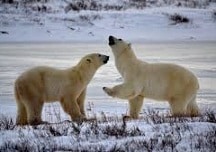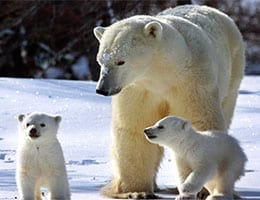 The polar bear is a mammal that is characterized by its pointed snout, somewhat flattened head, and white fur. As its name indicates, this species belongs to the family group of bears or ursids and lives in the polar region (specifically in the area of the north pole ).
The polar bear is a mammal that is characterized by its pointed snout, somewhat flattened head, and white fur. As its name indicates, this species belongs to the family group of bears or ursids and lives in the polar region (specifically in the area of the north pole ).
Also called the white bear , the polar bear is one of the largest carnivores on the planet. It is a super predator : it is located at the top of the food chain and lacks natural predators.
The polar bear, like the rest of the ursids, is plantigrade . This means that, when moving, you rest the entire soles of your hands and feet on the surface. Large size, thick fur, claws and small eyes are other defining features.
Like many other species today, the polar bear family tree has a long history. It is believed that its most remote ancestor is the Siberian brown bear , which lived until about 300 thousand years ago.
The polar bear's natural habitat is the northern maritime regions of Canada , Alaska , Norway , Greenland and Siberia . Thanks to its excellent swimming abilities, it can catch fish , walruses and seals for food.
Beyond swimming, polar bears often travel on ice floes to find food . On land, they may feed on reindeer .
The robustness of the polar bear not only helps it hunt and prevail over the animals in its environment, but is also related to the resistance to cold that it needs so much to survive and also to its incredible ability to walk for hours to cover such impressive distances. like many thousands of kilometers.
Another of its most characteristic features is the acuity of its sense of smell , which is compared to those of a few species. Some studies indicate that a polar bear can detect a live seal carcass covered in snow from a kilometer away, and a carcass from approximately thirty kilometers. Although their vision does not seem to considerably surpass that of a human being, their hearing is much more precise, with better spatial detection of sounds and a much greater range in both directions (low and high).
 Despite being such a large and heavy animal, the polar bear does not lack agility but is perfectly prepared to face all the physical challenges that nature presents to it in its daily life. For example, it can jump several meters, swim skillfully at almost 10 kilometers per hour without resting for long distances, and climb steep slopes with an inclination of up to 45 degrees.
Despite being such a large and heavy animal, the polar bear does not lack agility but is perfectly prepared to face all the physical challenges that nature presents to it in its daily life. For example, it can jump several meters, swim skillfully at almost 10 kilometers per hour without resting for long distances, and climb steep slopes with an inclination of up to 45 degrees.
Humans , on the other hand, are the main threat to polar bears. The Eskimos , for example, used to hunt them for their skin and meat. These bears also tend to be victims of sport hunters and people who kill them so that they do not attack their domestic animals or raid towns.
The main current risk to the subsistence of polar bears, however, is the pollution that we generate with our lack of respect for the planet and other species. Due to global warming , its ecosystem is suffering alterations that threaten its survival.
Polar bear reproduction is especially slow, a very unfortunate fact given the state of risk in which they are found. Sexual maturation of the female reaches approximately 4 years of age, and the male reaches it a year later. Once the dominant male manages to mate, a gestation process begins that can exceed 260 days before the female gives birth.
